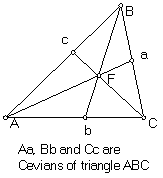The Euler Society Newsletter
|
Volume 1, number 1
January, 2002 |
Visit the Euler Society home page at
http://www.eulersociety.org |

The Euler Society Newsletter
|

|

A really nice talk about one of Eulerís late papers, E-749 (O.O. I.26 344-358) about when the sides of a triangle can be translated to make cevians of a new triangle. For our readers who are not Geometers, the figure at the right illustrates what cevians are. They are three line segments, each joining a vertex of a triangle with a point on the opposite side, with the special property that the three segments intersect in a single point. Segments Aa, Bb and Cc are cevians because they all pass through the point F. In this paper, Euler admits to "longae ambagae", or "extensive wanderings."
Euler followed up on Hippocratesí work with papers in 1737 (E-73 O.O. I.26 1-14) and 1771 (Iím not sure what paper this is), showing that there really arenít very many lunes for which Hippocratesí construction works.
Una added to the remarks Stacy Langton had made the day before, and showed how some lunes are almost constructible.
An account of how Euler did the first general work on Calculus of Variations as a homework assignment for his mentor in Basel, Johann Bernoulli. The homework was published and is E-9 (O.O. I.25 1-12)
Rob told us how Euler and d'Alembert got along for a while, then didn't, and compared how their lives were so similar in some ways, so different in others.